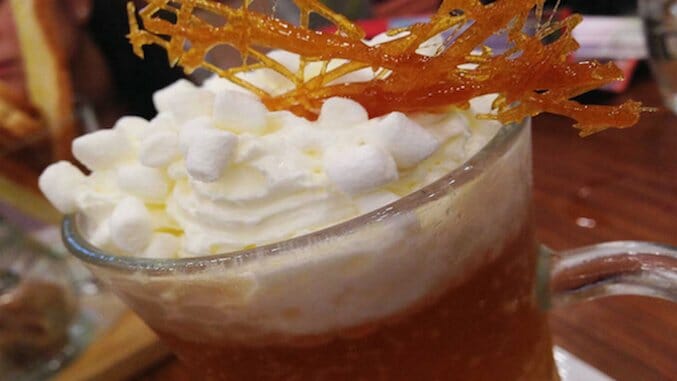Cooking Like a Wizard
Photo: John Ong/Flickr
The hardest part about trying to cook like a wizard is the magic.
Unfortunately, I don’t have a magic wand that I can bewitch to chop onions, or the ability to clear a table and wash dishes with a flick of the wrist. But the real challenge I encountered when trying to recreate some of the wizarding world’s more memorable recipes at home was figuring out how to make the food enchanted.
This is the world of licorice candies that bite, chocolate that jumps and lollipops that burn holes in your tongue. Without any training in spells or incantations, what’s a Muggle to do?
Food plays a significant role in the Harry Potter books: magical treats help define and describe the world of witches and wizards; pubs like The Leaky Cauldron and sweet shops like Honeydukes provide the setting for many crucial scenes and secret meetings; and of course, meals shared form the basis of friendships, family and community. Harry and Ron’s friendship begins over a pile of pumpkin pasties and Bertie Bott’s Every Flavour Beans on the Hogwarts Express; Kreacher the house elf demonstrates his change of heart by cooking comfort food for Harry, Ron and Hermione while they search for Horcruxes; and of course, there is Molly Weasley, packing her children piles of sandwiches when she sends them off to school (even if she can’t remember that Ron doesn’t like corned beef).
In general, the food of the wizarding world is either enchanted food with magical properties, or Muggle food that just happens to be made using magic. I decided to tackle the hard stuff first: figuring out how to recreate some of the magical food at home.
I picked two candies I was most intrigued by: chocolate frogs and fizzing whizbees. Chocolate frogs are among the first treats Harry encounters in the wizarding world; while he and Ron bond over the wizard trading cards in the package, Harry gets his first glimpse of Albus Dumbledore. Harry loses his first frog, though, as with its “one good jump,” it leaps out the window of the moving train.
When figuring out how to recreate chocolate frogs, I took some comfort from Ron’s reassurance that the frogs aren’t real; their jump is just a spell. My task, then, was to imagine how to make chocolates that might have some jump in them. I decided to go with chili peppers.
I used a basic recipe for dark chocolate bark, but into the melted chocolate I added a few pinches each of chili powder, paprika, and cinnamon. When I poured the melted chocolate into the frog molds (which I found on Amazon), I sprinkled a dash of crushed red pepper onto each, so that the extra kick of spice would lay right against your tongue when you bit into one. The chocolates themselves might not jump, but when I tried one, I sure did, hopping back and forth a few times on each foot until the momentary spiciness passed. These chocolate frogs may not be magic, strictly speaking, but I’d bet they’d put a spring back in your step after an encounter with a Dementor.
Up next were Fizzing Whizbees, described by Ron as massive sherbet balls that make you levitate off the ground for a few minutes. Though the Universal Studios Wizarding World theme parks do sell these, the Whizbees you can try there are actually chocolate bees with a fruity, Pop Rocks center, which doesn’t seem to match the book. I wanted to make something a little closer, and the first thing I discovered was that one of my key perceptions was off. Because Harry Potter is a Brit, sherbet in this case doesn’t mean the fruit frozen treat, but rather a fizzy sweet powder—think Pixie Sticks or Kool-Aid mix.
I knew to capture that thrilling fizz for this treat, I was going to need some kind of reaction, and because I’ve never been much good at chemistry, I let Google guide me. When I searched for Kool-Aid fizzy sherbet balls, I found that another Harry Potter fan had already tried her hand at recreating a more accurate version of these treats, and I went with her recipe: Kool-Aid mix, confectioner’s sugar and baking soda bound with coconut oil and made more fantastical with the addition of some neon food coloring. The coconut oil keeps everything together, but since it’s water that creates the fizzing reaction, you get this wonderful tingling sensation when you pop one into your mouth.
I deviated from the recipe only by making each Whizbee even bigger — the book does say they are massive — and they worked perfectly. When I first tried one, I giggled out loud at the fizzing sensation dancing on my tongue. Between that and the massive sugar rush each Fizzing Whizbee contains, I think these are as close to levitation as possible without any changes to the laws of gravity.
-

-

-

-

-

-

-

-

-

-

-

-

-

-

-

-

-

-

-

-

-

-

-

-

-

-

-

-

-

-

-

-

-

-

-

-

-

-

-

-








































